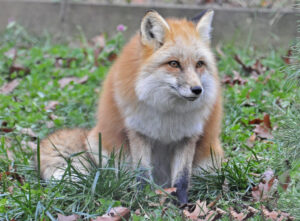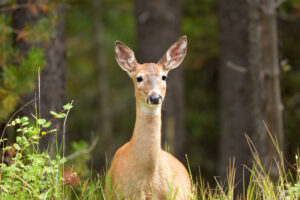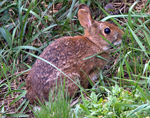
This image is licensed under CC B.Y. 2.0
Mammals, mammals, mammals! They are so cool! Many mammal species can be found within the refuge, so keep your eyes peeled when you are out and about on the trails. What makes a mammal a mammal, you may ask? Well, all mammals are warm-blooded, have hair or fur, and produce milk to feed their young. While visiting the refuge, look for white-tailed deer bounding through the forest on their nimble legs, rabbits scurrying under thick brush, otters peeking their heads up out of ponds, and red foxes with their stunning red fur and bushy tails. A few of these species are endangered, including the New England cottontail and Northern long-eared bat. However, the Refuge has worked to address their needs by protecting and creating habitats such as pollinator gardens and “Rabbitats.” See the Friend’s brochures on “Rabbitats” and pollinator gardens for more information.

Even if you cannot see any animals, it does not mean that they are not there. Look for signs of mammal activity like tracks, dens, scat, or food scraps. Many of these species may be wary of humans and difficult to spot, but their presence is noticeable if you are observant. Do you see any holes in the ground? These could be homes or dens for burrowing mammals like foxes, groundhogs, voles, and skunks. What about chewed-on acorns or fish carcasses? These could be signs of hungry chipmunks, squirrels, raccoons, or otters. Also, think about where you are. What animals do you think live in that habitat type, whether its forest, meadow, or pond? For example, cottontail rabbits enjoy brushy habitats with plenty of cover from predators, so there may be a rabbit or two hiding under that tangle of brush and vines, even if you cannot see them.

However, seeing an animal in person is a wonderful experience that can bring a person closer to nature, as long as it is done safely and with respect and consideration for the animal. Here are some tips from Mass Wildlife to enhance your wildlife viewing experience:
- Sit and Scan – Find a tranquil place to sit quietly. Be as still as you can but turn your head slowly and scan your surroundings with your eyes or a pair of binoculars.
- Walk Slowly and Quietly – Avoid quick movements or creating enormous amounts of noise when you walk in a wilderness area.
- Time of Day is Important – Early in the morning or later in the evening or the best times for seeing wildlife.
- Don’t Knock the Small Stuff – A squirrel can be just as interesting as a fox or bear, so don’t worry about not seeing any “big” or “rare” wildlife and enjoy the interesting behavior of smaller or more common critters.
Want to learn how to identify mammal tracks? See the following resource:
https://www.mass.gov/doc/identify-animal-tracks/download
Wildlife Viewing Tips and Tools from Mass Wildlife (Here is the full page):
https://www.mass.gov/info-details/wildlife-viewing-tips-and-tools
(Article researched and written by Grace Vachon, AmeriCorps Cape Cod)
